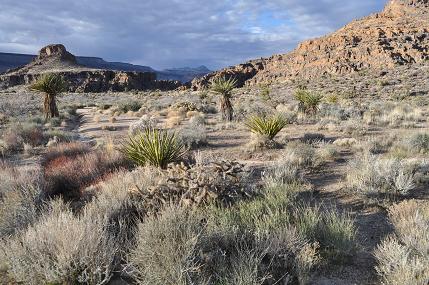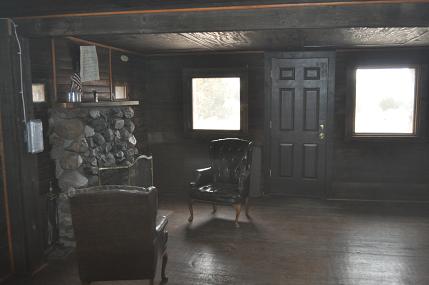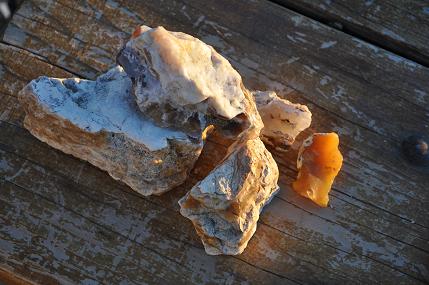At the foot of the Providence Mountains in the East Mojave Preserve is Hole-in-the-Wall campground. Its biggest asset is nothing; nothing but stillness, cactus, sweeping desert vistas , and walls riddled with natural holes. At night there is nothing in the sky but brilliant stars. In the morning, there is no sound but for the cry of a quail or call of a cactus wren. There is nothing to block the view of the sunrise and the glow off the mountains as the first rays penetrate the dark.

We arrived to find only 3 of the 35 campsites occupied. The park is in excellent shape, under the care of the National Park Service. We met the camp host who was doing a 4 month stint from his home in Canada. He joined us at our morning campfire as did a fellow camper from Los Gatos who was traveling alone towing his $32,000 16 foot airstream. We shared stories of our adventures.
One reason for traveling to the area was to visit Mitchell Caverns to get up to date information for an article I was writing. We were surprised to find the caverns were closed. Although adjacent to Hole-in-the-Wall and within the Preserve, the caverns were taken over from Jack and Ida Mitchell in the 1950s by the State and due to “budget cuts” they are temporarily closed.
To reach Hole-in-the-Wall take the Essex Road turnoff from I-40, or for Route 66 buffs, take the Mitchell Caverns road out of the town of Essex. The Hole-in-the-Wall road, now paved, is 10 miles to the campground. We paid $6 a nite with our Golden Age card, otherwise the fee is $12. There is water, a dump, pit toilets, tables and fire pits. There is a ranger station but you must bring your own fire wood, etc. We enjoyed chilly but still weather, missing the winds which can be devastating at times.
SIDE TRIPS IN THE AREA:

We made a stop at the Rock house, built in the late 1920s by Bert Smith who came to the area for weather more suited to his ailments. Later the house was occupied by Carl Faber, an artist, who enjoyed many visitors to his studio.
A trail from the house passes the remnants of an old copper mine, and then traverses down the hillside to Rock Springs where a U.S. Army post was established in the late 1860s. This was one of a string of posts erected to protect the mail and supply route along the Mojave Road. These posts were generally established around water supplies, such as Rock Springs.

Taking the Wild Horse Canyon loop road, we turned off to an area where some years ago Alan had found Chalcedony – a variety of quartz. He parked the car, walked about 50 feet and came back with a handful of the rocks!
Continuing to Mid Hills Campground, there was sad evidence of the destruction caused by a raging wildfire several years ago. The campground remains open but many of the sites are surrounded by charred junipers. Patches of snow remained and few campers were braving the elements.
We looped around to Lanfair Road and drove by Goffs, gassed up at Fenner ($4.35 a gallon), drove on Route 66 to Essex and then up Jack Mitchell’s road back to camp.
OFF TO JOSHUA TREE VIA AMBOY
Homebound we drove along Route 66, stopping in Amboy to check up on the status of the town which is being renovated by the Juan Pollo czar, Alfred Okura.
For some reason Alan was enamored with the following photo:
ON TO JOSHUA TREE LAKE (?) AND WILLIE BOY’S SALOON
In the town of Joshua Tree, 5 miles east of Hwy 62, is Joshua Tree Lake, better described as a large pond. The RV park has hook ups for RVs and also tent sites. There was a pool and spa but they are out of service. You can fish in the lake and the camp host rents poles and sells bait. It was actually a quiet and relaxing camp. The temperature never went over the 50s so we did fine. I don’t think I’d like to stay here in the summer (unless they open the pool).
WILLIE BOY’S SALOON AND RESTAURANT OPENED A FEW WEEKS AGO IN MORONGO VALLEY. WE ATE THEIR STEAKS AND DRANK THEIR ALE AND ENJOYED THE AMBIENCE.
The saga of Willie Boy and his sad fate were recreated in a movie called “Tell Them Willie Boy Was Here.” Although the details of this historical event are murky and vary from story teller to historian, the gist is merely this: In 1909 Willie Boy (played by Robert Blake), a Paiute-Chemehuevi Indian ran off with his forbidden love, Carlota, but not after killing her father. He was chased by a posse (Sheriff Robert Redford). In the chase Carlota was shot dead. Some say Willie Boy did away with her, others insist it was a bullet from the authorities. In the end, Willie Boy died from a gunshot. Did he kill himself or was he the victim of the hunt? The story goes his body was cremated and he was buried in Johnson Valley near Landers. We have hiked to his grave which is surrounded by a barb wire fence and marked with a plaque. The event has historical value because it is said to be THE LAST WILD WEST MANHUNT!
